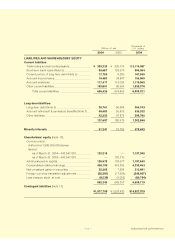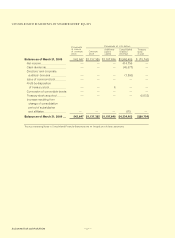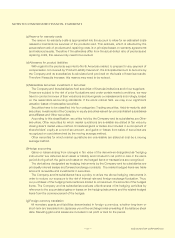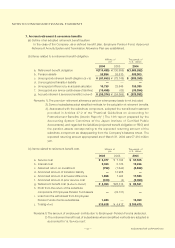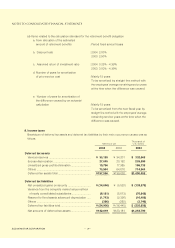Suzuki 2004 Annual Report Download - page 30
Download and view the complete annual report
Please find page 30 of the 2004 Suzuki annual report below. You can navigate through the pages in the report by either clicking on the pages listed below, or by using the keyword search tool below to find specific information within the annual report.
SUZUKI MOTOR CORPORATION
(c)Reserve for warranty costs
The reserve for warranty costs is appropriated into the account to allow for an estimated costs
related to maintenance services of the products sold. This estimate, which is affected by the
actual defect ratio of products and repairing costs, is in principle based on warranty agreements
and historical results. Therefore if the estimates differ from the actual defect ratio of products and
repairing costs, this reserve may need to be revised.
(d)Allowance for product liabilities
With regard to the products exported to North American market, to prepare for any payment of
compensation not covered by "Product Liability Insurance", the anticipated amount to be borne by
the Company and its subsidiaries is calculated and provided on the basis of historical results.
Therefore if lawsuits increase, this reserve may need to be revised.
(e)Marketable securities, investment in securities
The Company and its subsidiaries hold securities of financial institutions and of our suppliers.
These are subject to the risk of price fluctuations and under certain market conditions, we may
have to conduct a review of their valuations and downgrade our assessments accordingly, based
on the reasonable accounting standards. If the stock market falls, we may incur significant
valuation losses of marketable securities.
Securities have to be classified into four categories; Trading securities, Held-to-maturity debt
securities, Investments of the Company in equity securities issued by unconsolidated subsidiaries
and affiliates and Other securities.
According to this classification, securities held by the Company and its subsidiaries are Other
securities. Other securities for which market quotations are available are stated at fair value by
closing date's market value method. Unrealized gains or losses are included in a component of
shareholders' equity at a net-of-tax amount, and gains or losses from sales of securities are
recognized on cost determined by the moving average method.
Other securities for which market quotations are unavailable are stated at cost by a moving
average method.
(f)Hedge accounting
Gains or losses arising from changes in fair value of the derivatives designated as "hedging
instruments" are deferred as an asset or liability and included in net profit or loss in the same
period during which the gains and losses on the hedged items or transactions are recognized.
The derivatives designated as hedging instruments by the Company and its subsidiaries are
principally interest swaps and forward exchange contracts. The related hedged items are trade
accounts receivable and investments in securities.
The Company and its subsidiaries have a policy to utilize the above hedging instruments in
order to reduce our exposure to the risk of interest rate and foreign exchange fluctuation. Thus,
our purchases of the hedging instruments are limited to, at maximum, the amounts of the hedged
items. The Company and its subsidiaries evaluate effectiveness of its hedging activities by
reference to the accumulated gains or losses on the hedging instruments and the related hedged
items from the commencement of the hedges.
(g)Foreign currency translation
All monetary assets and liabilities denominated in foreign currencies, whether long-term or
short-term are translated into Japanese yen at the exchange rates prevailing at the balance sheet
date. Resulting gains and losses are included in net profit or loss for the period.
30
NOTES TO CONSOLIDATED FINANCIAL STATEMENTS






